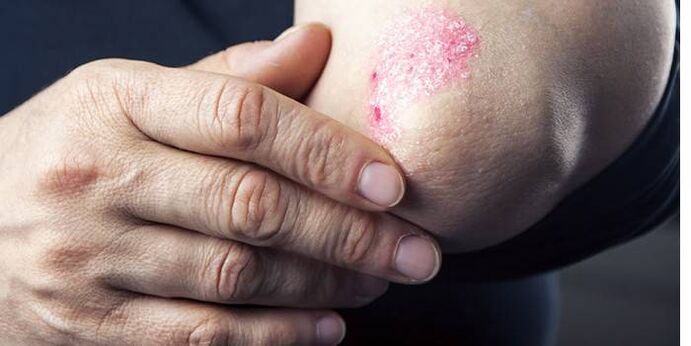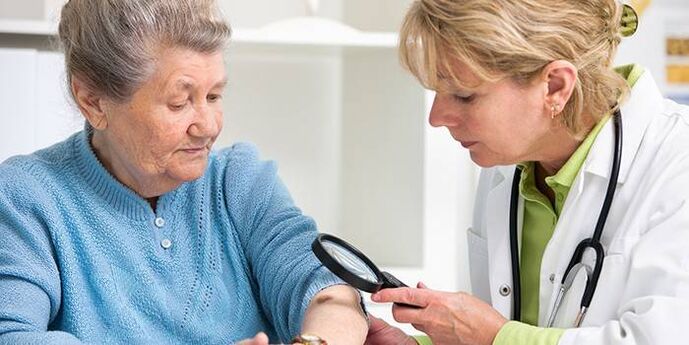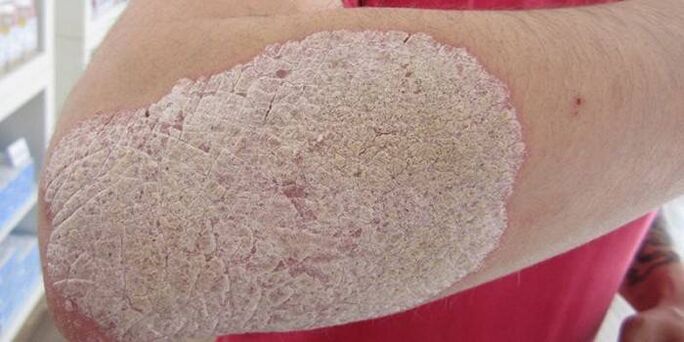Skin diseases are accompanied by the appearance of unpleasant symptoms and psychological discomfort. One of the common diseases that require immediate treatment of the skin is psoriasis of the elbows, and the choice of means is not limited to the use of topical preparations. If you do not do therapy in time, then a little inflammation will soon develop from a cosmetic problem into a medical one.
What is elbow psoriasis
The disease, which is characterized by the appearance of several spots in the bending of the limbs, is characterized by unpredictability and cyclicity. Elbow psoriasis is a chronic skin disease that begins with the appearance of papules and grows to plaques (large diffuse lesions) with scales of white, silvery, reddish hue. Slightly raised damaged areas are formed due to the accumulation of dry dead cells. If the inflammation is not treated, the disease will progress with alternating periods of exacerbation and remission.
Symptoms
When crusts form on the elbows, you can immediately notice the damaged areas of the skin. The signs of the disease are clearly visible immediately and it is rarely possible to completely cure psoriasis in the area of arm flexion. The chances of successful recovery are those patients who have consulted a doctor in time. Anxiety should be disorders of the skin of the elbows, which are similar to the following symptoms of psoriasis:
- Red plaques or scaly spots, which at first look like papules with a white film, but with the aggravation and development of the disease they grow, bind to each other and become covered with white scales.
- Itching of the skin, which provokes even greater damage to the skin. Like other mechanical damage to the skin, such as scratches, cuts, such inflammation of the elbows scratches, injures the skin and this leads to the appearance of new spots.
- Severe redness, inflamed areas of the skin begin to bleed.

Plaques on the elbows
Psoriasis can occur in the groin, body, limbs or head, but wherever the disease is located, plaques are a sure sign. Wounds on the elbows in the form of red spots with white scales appear more often due to the openness of this area of skin, as it is easy to damage. The altered area of the epidermis becomes inflamed, the red scaly spots gradually increase and can cover the entire elbow. In a neglected form, the plaques can bleed, and in an attempt to scrape, the phenomenon of "stearin stain" appears, as after a drop of hardened wax.
Reasons
Ongoing research has not yet been able to determine with certainty the source of the onset of the disease, and medical versions of the causes of elbow psoriasis include the following:
- Genetic predisposition is an important statistical factor. If one of the parents has chronic inflammation of the skin, then the child is more likely to get psoriasis.
- The penetration of specific substances penetrating through the injured areas of the skin. Affected areas of the epidermis begin to thicken, the body begins to fight unusual symptoms and rejects cells, which externally manifests itself as fungus on the elbows.
- Disruption of the work of T-lymphocytes, which face the task of creating a barrier to pathogens.
- Silicon deficiency in the body.
- Endocrine diseases.
- Serious limb injuries.
- Severe mechanical damage, non-healing wounds.
- Emotional, mental stress.
- Long-term treatment.
- Weak immunity.

stages
Chronic inflammatory process of the elbows, which under the influence of a number of reasons intensifies or decreases and proceeds without appropriate treatment. The course of therapy should be prescribed by a dermatologist, but to determine the effectiveness of the method, the choice of drugs, procedures, the doctor must assess the course of the disease. Further tactics will depend on the clinical picture, while it is common to distinguish the following stages of skin lesions of the elbows with psoriasis:
- Initially. The surface of the skin on the outside of the elbows is covered with a rash. Reddish spots with a rounded shape with a white film grow, are covered with scales and after 2-3 weeks plaques form. With timely treatment, the signs of psoriasis may disappear for a while and then reappear or the lesion may reappear in another part of the body.
- Progressive. This stage of the disease can be characterized by the presence of psoriatic elements with many scales. The appearance of such signs indicates the beginning of exacerbation of psoriasis and it is easy to notice the presence of a hyperemic edge (redness) on the edge of the scaly plaques.
- Stationary. It is characterized by a reduction in the inflammatory process, which shows the effectiveness of the treatment used. The appearance of new plaques on the elbows stops, there is no red edge around the psoriatic elements, their diameter decreases, while the scales completely cover the inflamed area.
- Regressive. This shows a partial recovery, while the peeling is almost imperceptible or disappears, pigmented areas of skin appear at the site of plaques. An additional set of measures will be aimed at preventing exacerbations of psoriasis.

Forms
The undulating course of the disease, when the spontaneous period alternates with improvement, is not the only component of the insidiousness of psoriasis. The severity of the inflammatory process depends on the nature of the rash, another important factor is the shape. The localization of rashes on the elbows often reveals a simple (vulgar) type of disease, which is characterized by redness, scaling, itching. The neglected form of the disease threatens with complications and the appearance of pustular, erythrodermic, seborrheic type of psoriasis - with them the area of the lesion will expand.
How to treat psoriasis of the elbows
There are effective methods of therapy, but it will not work to completely clean the skin of the elbows, as psoriasis belongs to the group of incurable diseases. The whole system of complex treatment will be aimed at the maximum elimination of external signs. The duration of remission depends on many factors and in order to eliminate the manifestation of psoriasis, it is recommended to establish a treatment regimen using such basic methods as:
- topical therapy (ointment, cream, lotion);
- physiotherapy procedures;
- phototherapy;
- special diet;
- intake of vitamin and mineral complexes.
The cure for psoriasis of the elbows
The drugs are actively used in the treatment of multifactorial disease, but their effectiveness is observed only in combination with other means. External medications are commonly used to treat psoriasis, and if they are ineffective, the following medications may be prescribed:
- cytostatics;
- antihistamines;
- enterosorbents.
Ointment
A quick way to get rid of the unpleasant symptoms of psoriasis is local treatment. Ointments with vitamin D, zinc, tar are called to help remove dead cells, moisturize the skin of the elbows, and hormonal agents help to cope with more severe forms of the disease. Corticosteroids are relatively safe if used as directed by a doctor who has examined psoriatic plaques on the elbows, assessed the condition of the upper layers and the extent of the lesion. Only a dermatologist can introduce hormonal ointments in the treatment regimen, self-medication is strictly prohibited!
Alternative treatment
Compresses, lotions, decoctions, baths can rightly be considered no less useful methods of treating psoriasis. If the plaques on the elbows are covered with a white film, then at home itching, redness can be conveniently removed by immersing the affected areas for 7-10 minutes in a cool herbal solution. The composition should be selected individually, boiled with boiling water, but hot baths should be avoided. Among the herbs useful for treating psoriasis are:
- celandine;
- chicory root;
- valerian root.

Prevention
There is no reason to assume that psoriasis will go away on its own, but self-medication is also not worth it, as there is a risk of worsening the course of a chronic disease. Eliminating the inflammatory process is the first step to recovery, as for long-term remission you will need to follow some doctors' recommendations. To avoid exacerbation of psoriasis, it is necessary to adhere to such preventive measures:
- follow a proper diet;
- exclude the use of alcoholic beverages, alcohol, pastries, spicy foods;
- get enough sleep, while the duration of sleep should be at least 8 hours a day;
- avoid mechanical damage to the skin, injuries;
- monitor the internal state of the body;
- develop skills to deal with stress;
- support the functioning of the immune system by avoiding infectious diseases;
- minimize contact with household chemicals.
Photo of elbow psoriasis
























